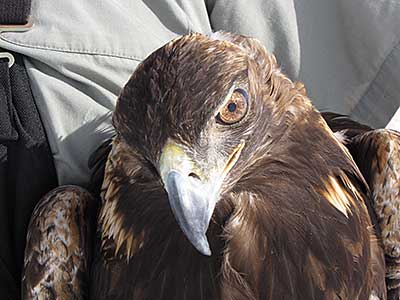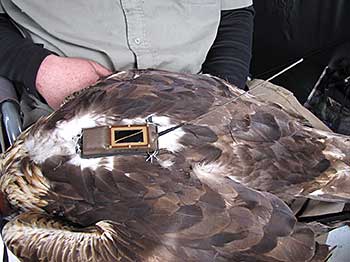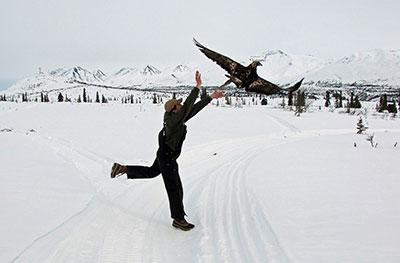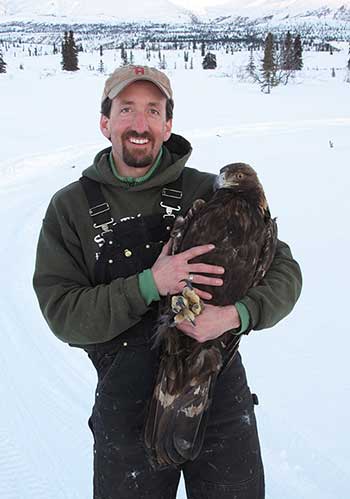Alaska Fish & Wildlife News
July 2014
Tracking Golden Eagles

State and federal biologists in Alaska, spurred by an easing of federal protections for golden eagles and ongoing habitat loss in western states, are pooling their efforts to learn more about one of North America’s largest raptors. A masterful predator, a speed demon in flight, a sky-dancing paramour, the golden eagle is also—in its northern latitudes at least—a bird of mystery. How many breed and raise their young in Alaska, how are they distributed, where do they migrate to in winter, and what challenges do they face there?
“We’re on the edge of a big frontier. We really don’t know that much,” said National Park Service (NPS) biologist Carol McIntyre whose 27-year study of Denali National Park’s golden eagles is the most comprehensive information to date. “The collaboration is necessary because we have a really big state and we need to learn a lot fast so we can help the U.S. Fish and Wildlife Service (USFWS) and others develop conservation plans that address these migratory golden eagles.”
A driving force behind the effort is the recent USFWS decision to permit a limited number of accidental golden eagle kills at wind farms in the Lower 48. McIntyre and biologists Travis Booms of the Alaska Department of Fish and Game (ADF&G) and Steve Lewis of the USFWS are interested in how these facilities, their associated infrastructure, and other changes are affecting Alaska’s golden eagles on their southern wintering grounds. They plan to track their movements over the next few years by attaching satellite transmitters to a sampling of eagles captured in various regions around Alaska. Booms’ project near Gunsight Mountain along the Glenn Highway was the first to get underway.
Gunsight Mountain is well known among birders as a busy raptor migration corridor and golden eagles are the early birds each year. They begin showing up in late February and by peak migration in late March or April, several hundred a day may be streaming silently past this squeeze point between the Chugach and Talkeetna Mountains. Most often the eagles travel alone but as many as 15 eagles have been observed catching rising air thermals and spiraling upwards in what’s called a “kettle” of birds, like a pot left on to boil.
Kettling is one way that eagles conserve energy. Booms said migration is taxing on the birds and at that time of year prey is often scarce. He considered their needs when setting up the capture site.
“A lot of migratory birds haven’t arrived yet, like ducks and geese, and ground squirrels clearly are not out of their burrows yet,” he said. “So they are relying primarily on ptarmigan and hare, and it’s becoming apparent they’re pretty reliant on carrion as well.”
Lewis, Booms, and ADF&G biologist Chris Barger launched a pilot study at Gunsight in spring 2013. They picked a capture site along the snow-covered high open plateau between ranges, baited it with moose and caribou road kill from a nearby Fish and Game office, set up a remote-controlled net launcher, and waited behind a blind about 100 yards from the site. How did the eagles reward their efforts?

“We had a goose egg,” said Booms who said not one bird came down to inspect the carrion in the two weeks they were there. “It was pretty humbling to put a whole lot of effort into a project and not have any success at all.”
So they chalked it up as a learning year. Booms went back to the drawing board, thinking through all the little nuances and variables that go into trapping an eagle. He said part of the problem was spring arrived late that year and there weren’t a lot of eagles moving through when they were on site. Still, he’s convinced the main problem was lack of preparation.
“A lot of really small details that you wouldn’t normally think about are critically important,” he said. “It’s orchestrating a whole lot of little levers so that everything goes off at the right time, in the right situation, and at the right position. Because the one tiny detail you forget can cause you not to catch an eagle.”
This spring he and Barger were back in the general area, armed again with carcasses and a more powerful net launcher that allowed them to set up their blind a quarter mile back from the capture site. Booms said he was hopeful they would catch at least a couple eagles this time. Instead they caught fifteen—as many as he had transmitters for—over 15 days of trapping.
“I did not expect we would get all our transmitters out, or anywhere near all. But there’s always luck involved too and that’s one variable you cannot control,” he said.
They caught as many as one or two a day, following the same drill each time. An eagle would land on the carrion and they’d trigger the net launcher, a powerful four-barreled mechanism that sent a 40 foot by 30 foot net whizzing over the capture site. Quick and wary, the birds sometimes slipped the net before it settled, but with each one caught, they put a leather falconry hood on its head to calm it, worked the bird out of the net, covered its talons with leather booties (Booms said golden eagles aren’t much for biting, “but they can put a talon right through your arm or torso, no problem…”), then wrapped the bird in a vest to hold it still.
“All this helps calm them down,” said Booms who added that none appeared to suffer any harm other than a few ruffled feathers.
The transmitter is about the size of a Bic lighter and weighs 45 grams or 1.6 oz (about 2 percent of the bird’s weight). It rests between the wings at the center of the bird’s balance point and is attached to a backpack style harness, which wraps around the bird’s neck and waist and connects at the sternum. Booms said he expects the units to stay on for about two to four years, but a bird determined to work it loose could remove it sooner.
A tiny GPS inside records the bird’s latitude and longitude every hour for 12 hours every three days and sends the data out via a satellite network. Within a couple weeks, Booms had a pretty good idea of where most were based for the summer. The adults had settled into their breeding territories in the Gunsight area, around South Central Alaska, and into the western Alaska Range where rugged cliffs, mountainous terrain, and flourishing prey populations are suited to their needs. Non-breeding eagles tend to roam across a broader range. In autumn, most golden eagles migrate south where they range throughout southern Canada, the western U.S., and northern Mexico. Booms said finding out exactly where they go will help researchers begin to gauge the risks they face outside Alaska.

The burgeoning wind farm industry has been particularly lethal to golden eagles because wind turbines and eagles share an affinity for the same windy ridgelines. Other raptors travel the ridgelines as well, but golden eagles are particularly vulnerable. They conserve energy by using their broad wings to hover on updrafts created when surface winds hit the sloping terrain. Soaring low over the ridgeline as they scan the ground for prey can put unwitting eagles on a direct collision course with the spinning rotors.
Though federal laws like the Bald and Golden Eagle Protection Act and the Migratory Bird Treaty Act make it illegal to harm or kill eagles, the new permit system allows for a limited golden eagle take as long as the permit holder has taken measures to reduce their mortality and provides mitigation for the loss of any eagles.
Lewis said the Service is struggling to determine the best way to mitigate for such losses. A wind project east of San Francisco was recently awarded the first permit, which requires the company limit take to five golden eagles over a five year period. By way of mitigation, the company must pay to retrofit 133 power poles to prevent eagle injuries and deaths from electrocution, another common source of eagle mortality.
“The way mitigation is defined is it has to provide a net benefit to eagles and that’s hard to quantify,” said Lewis. “For birds (that breed) in Alaska, is the best way to mitigate for them to retrofit poles in the Lower 48? I don’t know, maybe it is.”
By tracking where Alaska eagles go in the winter, the study will begin to show if mitigation efforts are targeting the appropriate eagle population. For example, Booms said eagles that live year round in wind farm populated areas may be savvier about avoiding the risk.
“Now birds on migration or birds that move down there in the wintering period are probably not as familiar with that area and may be more susceptible to those threats than the local birds,” said Booms. “It’s a theory but I think it’s a reasonable theory and one of the reasons why we want a better understanding of where Alaska’s eagles go and what kind of threats they’re facing.”
Wind turbines and transmission lines are not the only threats to golden eagles. Lead poisoning from gunshot and landscape alteration from development or natural events like drought and fire can affect their health and ability to find prey, and that could have a crossover effect on the breeding grounds. In Denali National Park, which boasts one of the highest known breeding densities of golden eagles, McIntyre’s study of 90 nesting areas has shown a significant drop in productivity.

“The probability of a female laying an egg has decreased by 25 percent in the last 23 years and nothing we can look at occurring on the breeding grounds explains that,” said McIntyre. “The hypothesis is that the females are returning to Denali in poorer shape now than 23 years ago. In order to test that we have to be able to identify individuals and look at their year round movements.”
From 1997 to 2002 McIntyre outfitted 48 fledgling golden eagles with transmitters to study the movements of sub-adults, but the new study will be her first opportunity to examine the migratory routes and wintering grounds of breeding adults. In a trial effort outside park boundaries this spring, she and Lewis captured and tagged (attached a transmitter to) an adult male on its breeding territory; no small feat, she said.
“We have a bird that is watching everything we do, every move we make. Capturing birds on their territory—a long-lived species that knows its territory well—can be pretty challenging,” said McIntyre.
Next year McIntyre and Lewis plan to continue tagging eagles on their breeding grounds, this time within the park boundaries. Booms is aiming to tag a total of 45 eagles by spring 2016 and may move beyond Gunsight Mountain to a location in the Arctic. McIntyre and Lewis also plan to work a migration corridor in the Mentasta Mountains area of Wrangell-St. Elias Park and Lewis may do some tagging in the central or western Brooks Range, though logistics are challenging off the road system. The researchers have some idea of the birds’ travel patterns based on McIntyre’s fledgling study, the Gunsight birds, and other efforts and will continue to monitor the incoming data to decide where to best concentrate their efforts for as broad a sampling as possible.
“There’s a pretty wide migration front so there’s no real good ‘this is the route’ that they all take,” said Lewis. “Basically we are doing a trade-off of logistics and getting birds that are on a good route.”
Lewis said the goal is to outfit 100 golden eagles with transmitters. Each unit costs $3,800 plus another $700 a year per transmitter for the satellite data feed. All three agencies are funding their portion of the study. McIntyre said the collaborative approach should yield a treasure trove of data.
“Different agencies are funding different levels of (the study) but it’s all being put together so the data can be looked at in a comprehensive way, not a piecemeal approach,” she said. “The Denali study is the only one of its kind in how long it has been conducted. We need to duplicate those efforts across the state, and that’s what Travis and Steve and I are trying to do.”
Gunsight Mountain Golden Eagle Release video - 40 seconds. More on Golden Eagles in Alaska.
Anne Sutton is a longtime Alaska journalist and directs the wildlife viewing program for the Alaska Department of Fish & Game.
Subscribe to be notified about new issues
Receive a monthly notice about new issues and articles.
